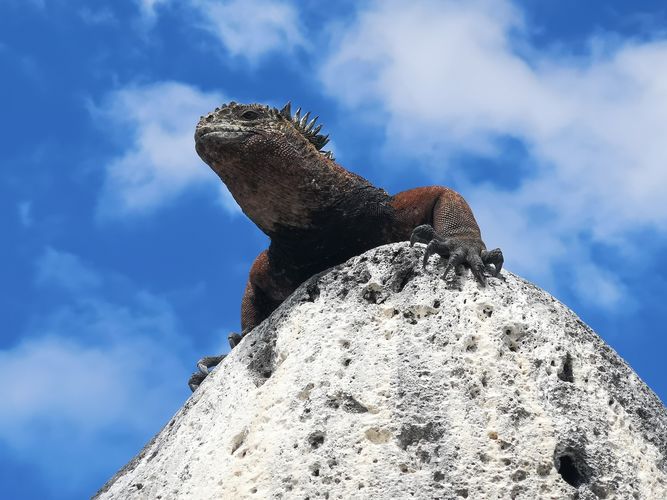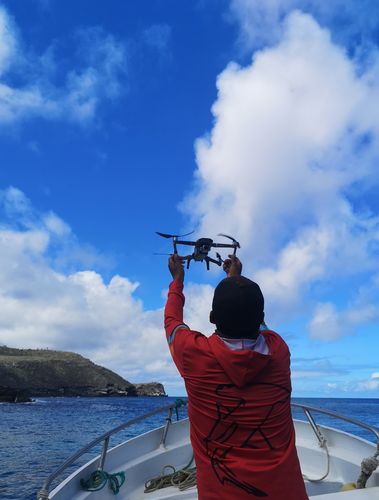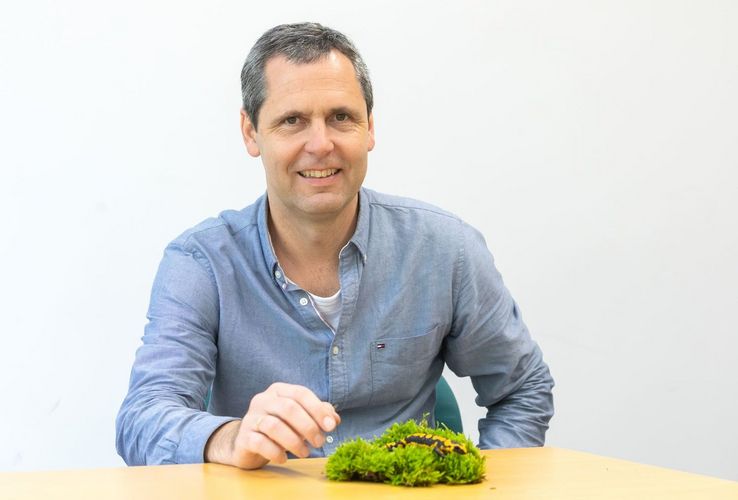Over the past few months, Dr Amy MacLeod and her expedition team have been using camera drones on two islands of the Galapagos archipelago to collect extensive aerial footage, specifically of the islands’ coastlines. For it is here, hidden away on stony and very rugged terrain, that the marine iguanas live. They have existed here, and only here – some 1000 kilometres west of Ecuador – for millions of years. These Methuselahs of evolution are the only lizard species in the world that seek their food in water. But their survival is increasingly difficult due to pollution, climate change and non-indigenous species such as cats. “The Galapagos marine iguanas are endangered. In order to help, we need to know how many there are and where we can find them,” said Dr MacLeod.
“Since the islands can be difficult to access due to lava boulders and sometimes high waves, we have used camera drones for the first time,” continued Amy MacLeod, who is associated with Professor Steinfartz’s research group. In addition to holding a doctorate in biology, she also teaches the subject at a bilingual secondary school in Berlin. “We launched the drones from a boat and began by flying them over the two islands of Santa Fé and San Cristóbal. It wasn’t always easy with the swell and the wind, but it worked out well. The drones also have the advantage that we don’t have to set foot on the islands ourselves, meaning we don’t run the risk of unintentionally affecting the sensitive ecosystem – for example by bringing in ants on our shoes.”
The team has divided the extensive photo material into 25,000 sections. Now these have to be analysed. Ecuadorian doctoral researcher Andrea Varela, who spends most of her time on site in the archipelago, plays a key role in the drone recordings as well as processing and analysing the images. The team has set up a project website on Zooniverse to help count the iguanas. “Conventional counting is not technically difficult, but it takes too long – so we are appealing to volunteers to help us,” said Amy MacLeod, who dealt with Galapagos marine iguanas for her PhD.
Following a brief introduction, anyone willing to help can view and classify aerial photographs on the website. The aim is not only to identify lizards, but also to record when other creatures such as birds, turtles, crabs, sea lions and algae are visible in pictures – but also plastic waste, which poses a threat to all marine life. The scientists stress the importance of classifying each image – regardless of whether any iguanas can be seen on it. “If we know for example that a place doesn’t have any lizards, then this is a sign that we need to look elsewhere.” The website is in English but the introduction is also provided in German and Spanish, so that as many volunteers as possible can participate.
“Following this pilot phase, we will compare the volunteers’ analyses with the expert counts performed by the team and other scientists. In this way, we hope to see whether the volunteers’ counts are reliable. If they are, we will continue to rely on the valuable contribution of volunteers in the future – and we very much hope this is the case,” said Amy MacLeod, explaining the next steps. At a later stage, artificial intelligence will also be used to conduct the census.
In the long term, the project aims to conduct a census on all 13 of the Galapagos Islands, in order to gain a full picture of the eleven subspecies of the charismatic iguanas that are distributed across the archipelago. Only then will the scientists be able to assess the overall situation and recommend measures for protecting the lizards. “I also hope, of course, that if lots of people contribute, this will help raise awareness of marine iguanas and make people more aware of the need to protect the environment.”
Parallel to the census project, a paper on the functions of secretion proteins of Galapagos marine iguanas was recently published in the American journal Molecular & Cellular Proteomics. This study was led by Professor Marcus Krüger and Dr Frederik Tellkamp from CECAD at the University of Cologne and Professor Sebastian Steinfartz from Leipzig University. “The male iguanas and other reptiles, and even some amphibians, have an array of special glands, called femoral pores, on the underside of their hind legs,” said the professor of Molecular Evolution and Animal Systematics. “It is assumed that these glands primarily serve communication between individuals of the same species by means of chemical molecules. Although many studies have examined the highly volatile chemical components of the femoral pore secretions, until now there has been practically no information on the composition of the protein fraction, which can account for up to 80 per cent of the chemical substances.”
In their current study, scientists from the University of Cologne, Leipzig University, TH Mittelhessen University of Applied Sciences, and the Max Planck Institute for Heart and Lung Research have now analysed this protein fraction. They identified more than 7500 proteins in total and in some cases were able to determine their function. “Contrary to our expectations, we were unable to find proteins that served a communication function,” said Steinfartz. “At the same time, we found that many of the proteins are part of the immune system. Of particular interest was the discovery of anti-microbial peptides which, in laboratory experiments, showed activity against bacteria similar in strength to oncocin, a well-known antibiotic.” The researchers assume that these proteins might serve to prevent infections via the femoral pores and/or prolong the function of volatile femoral secretions.
Publication on femoral proteins:
“Proteomics of Galápagos Marine Iguanas Links Function of Femoral Gland Proteins to the Immune System”, published in: “Molecular & Cellular Proteomics”, 1 September 2020
https://doi.org/10.1074/mcp.RA120.001947


































































